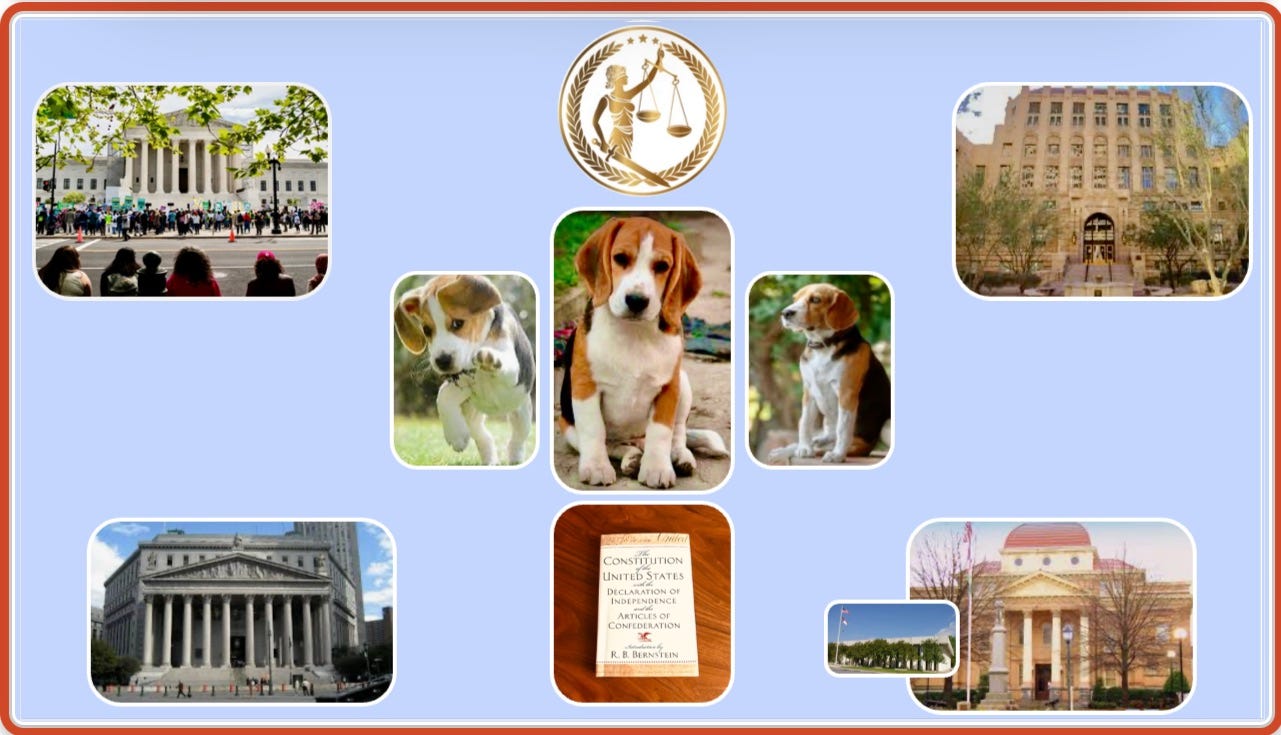Sunday morning greetings, with last week’s belated edition that took a detour just before post time.
Today’s closing section then offers a range of selected advance readings and a couple of visuals for browsing and pondering. It’s part of my own prep for upcoming editions discussing complex issues around this past week’s intensifying protests and the Hamas-Israel war. More on this process below, and I’ll value hearing from you with additional materials or advance perspectives you have.
title themes
The visual illustrates the original “Legal beagles at work… a surreal split-screen news week in American courts.” Simultaneous courthouse proceedings were under way, with vastly varying magnitude, geography and newsworthiness (if any).
The canine title image of this dog-with-a-bone breed of devoted master trackers points to an element common at all of the sites pictured: Some astonishingly good lawyering, on a full spectrum of matters from most monumental and public to merest mundane and individual.
Last Friday’s PBS News Hour had good overview, especially David Brooks and Jonathan Capehart on Supreme Court arguments over immunity for Trump.
Multiple court cases involving Trump were previewed, then well-summarized in Politico.
legal beagles
My personal lawyer-kudos here is by-no-means exclusive, comprehensive or an attempt at neutrality. The New York Times’ prologue to the gravely high-stakes Trump-immunity case before the U.S. Supreme Court does present such an across-the-aisle view: Here are the lawyers arguing the Trump insurrection immunity case before the Supreme Court.
I’m now able to revisit, as I wasn’t a week ago, what I actually heard that Thursday with some depth and wider perspective. So I begin today’s exploration here.
U.S. Supreme Court, Washington, DC
(Pictured at top left)
On April 26 that mid-morning, real-time live audio of this proceeding happened to extend well beyond lunchtime on a day that I could stay with it. (I would only later realize, I’d needed to. Even having heard them verbatim and gavel-to-gavel, it was a couple of days before full awareness of what I’d heard in these chambers: Statements made aloud and unapologetically — by nominal “conservative, non-activist, even originalist” justices who are sworn to serve our Constitution and democracy.)
What did sink in immediately, and remains for me most likely indelible, were the steady voice and solid force that was veteran constitutional solicitor Michael Dreeben — heard only in that weirdly once-removed, unseen audio-only version of real-time public scrutiny allowed in U.S. federal courts. (I had to Google Dreeben even to get a visual. Now I hope he takes good care of himself, drives carefully, has great security. I’d sleep better if only he could live in my neighborhood.)
Dreeben’s legal argument was nothing flashy. Just crystal clear, thorough, fact- and legal precedent-guided: That until the facts and defendant in the case before the Court for ruling today, throughout American history no presidents or former presidents have been granted by the founders under our Constitution — or needed, demanded or asked for — immunity for illegal acts committed during their presidencies. Until this defendant, this case, no U.S. President has challenged or been charged with subverting the peaceful transition of power.
To hold that composure for what came next, surely Dreeben needed to call on his deep, broad 30-plus-year experience and near record-setting 108 cases argued before the high Court. Yet the contrast with that same vast experience must also have made this hearing even more surreal and disorienting.
Over hours, four and occasionally five “conservative” justices repeatedly stated aloud their refusal to fulfill their basic obligation under the Constitution: to hear facts about, consider, discuss applicable laws and precedent, or even acknowledge the specific case before them in order to rule on it. Instead, again and again, they raised and concerned themselves with hypotheticals, stating their own desire to set new future precedent based instead on those.
As for this Court’s hearing-a-case-by-refusing-to-hear-about-the-case, unprecedented doesn’t begin to cover it.
The Court indicated no intention to hand down an expedited decision before close of the current session at the end of June. As with any other newShrink, here’s a sampling of stories…
news coverage
Republican Liz Cheney, former Congresswoman who co-led the House investigation and hearings on the January 6th attack and Trump’s role in it, had this op-ed in The New York Times earlier in the week before the pivotal hearing: The Supreme Court Should Rule Swiftly on Trump’s Immunity Claim.
Conservative Justices Appear Poised to Rule Ex-Presidents Have Some Level of Immunity (NYT)
4 Takeaways From the Supreme Court Hearing on Trump’s Immunity Claim (NYT)
Highlights from Supreme Court Arguments on Trump Immunity Claim (WAPO)
Here is Rolling Stone on things a president could legitimately do with immunity from prosecution, according to Trump lawyers and some US Supreme Court justices this week:
Trump Lawyer Says Having Political Rival Killed Could Constitute ‘Official’ Presidential Act
The Supreme Court heard oral arguments Thursday on the former president’s bid to secure sweeping immunity from criminal prosecution
On my first read that week, progressive attorney-activist Robert Hubbell’s Today’s Edition titled “Supreme Outrage,” seemed to me a bit fever-pitched and overstated. Revisiting it after several days of my own reflection, perhaps not so much. (To see what you think you can browse to www.RobertHubbell.substack.com, April 26, 2024.)
🔵
With jarring split-screen timing and more than a little irony, in Washington the Supreme Court seemed inclined to absolve hypothetical former and future presidents of at least some basic legal accountability under the law. That same morning, Arizona’s attorney general and a grand jury issued indictments squarely on the side of full accountability for those charged with serving this particular former president’s demonstrable illegal bidding. The 18 Arizona indictments charge former Trump chief of staff and re-election campaign aide Mark Meadows, lawyer Rudy Giuliani and false electors, with Donald Trump as an un-indicted co-conspirator. Here’s some coverage…
Maricopa County Courthouse, Phoenix, AZ
(Pictured at top right)
Arizona Charges Mark Meadows, Giuliani and Other Trump Allies in Election Interference Case (NYT)
DEMOCRACY IN AMERICA: Meadows, Giuliani and other Trump allies charged in Arizona 2020 election probe (WAPO)
Continuing meanwhile, moving at a brisk and what from here seems a consistently well-managed case so far…
🔵
Manhattan Criminal Court, NYC
(Photo at bottom left)
Here is overview and links to all of The New York Times coverage of various aspects of the Trump criminal hush money case now well under way in Manhattan. There are ongoing live updates, all accessible in a single central place.
5 Takeaways From the Second Week of Donald J. Trump’s Criminal Trial.
🔵
And most mundane, closest to home….
Iredell County Courthouse, Statesville, NC
(Photo and insert at bottom right.)
The picturesque historic facility in this Lake Norman area county seat, still used for some functions, dates to 1900. The un-inspiringly serviceable, ‘70s-era structure in the insert houses the current Clerk of Superior Court and other key public uses.
As it’s happened, amid so much high-profile national judicial-system news on personal front I’ve had multiple trips to the courthouse. There’s been just one, pesky piece of my late mother’s estate that had to wait and required actions after her death, then some back-and-forth at this county’s courthouse.
Two or three time-consuming rounds into this, I managed to override my default figure-it-out-for-myself mode on this one. On a great referral from friends I’ve hired a knowledgeable local specialty lawyer to finish this up and tweak some other things too.
It is both cool and strange to hire this impressive, experienced and likable barrister… who could easily be my son. (Perhaps I should clarify that I mean this entirely theoretically!)
🔵
About that week-long detour to today’s post…
“The Body Keeps the Score”
The well-known, useful book title, from psychologist and PTSD specialist Bessel van der Kolk, focuses on healing trauma. But its neurological basis, principles and psychological approaches apply as well to the full spectrum of our felt human experience, not solely the negative or incapacitating.
About this point in the post last Friday, pretty much all of the newShrink edition and brief closing item were largely completed minus just one piece. As is fairly normal, I’d opted to save for fresher time Saturday the thinking and adding of a few of my own comments, observations, thoughts and concerns regarding the pivotal Trump-immunity hearing before the U.S. Supreme Court.
Only Saturday afternoon, when I went to do that it clearly wasn’t normal at all. With no warning, food issue, fever or other “bug” indicators I was suddenly, deathly ill. Just once when preparing to write… Then literally leveled, horizontal on couch, bed or yoga mat/floor for the next 12-18 hours.
I dimly recalled a commentator a day or so before, describing “feeling almost literal physical, down-is-up-up-is-down vertigo” when trying to parse and process the Thursday Supreme Court hearing.
For awhile I was similarly unable to form a coherent thought about any of it. (As indicator of how rare this is, the last time I had thrown up was October 2002, and before that was in the ‘80s.) I’ve had these kinds of “pay attention” nudges on occasion, especially in the psychotherapy room or in situations of my trying to convince myself of things I more deeply didn’t want (ie job prospects that “should” appeal.)
Last week’s was unusually intense, but subsided as I fully absorbed how very not-business-as-usual and unsettling this Supreme Court hearing — and this Supreme Court, and former president/presidential candidate — are to me.
In depth psychology (which considers and pays attention to the unconscious/psyche) and with application in clinical psychotherapy, there’s an important phenomenon called somaticizing. Basically it’s when things — perceived images, feelings, overlooked facts, ideas, observations — enter our not quite fully conscious awareness that are profoundly at odds with the “official conscious/objective-reality” version of what’s supposed to be going on.
Whereas fact-checking and tracking falsehoods in order to address them is with conscious intent, this is better understood as a “tip-of-the-iceburg” sense of much bigger things lurking just below full awareness. It can be a very useful and needed nudge to pay closer, and more embodied, not just in-our-heads abstract, attention.
I bring this up to emphasize for a couple of reasons here, and now.
We are still early in a crucially important if not dire election year, and most of us by now are all too familiar with the Trump effect, a level of disordered, not-quite-rational chaos that surrounds and permeates the entire interactive field around him. It evokes, meets and stirs up the unconscious crazy chaos in us all, both individually and collectively. Naming the phenomenon doesn’t eradicate it, but at least helps zap its unconscious tugs on us.
Second, you may recall one of newShrink’s core goals of working toward our becoming a more deeply, widely informed electorate (and news consumers.) Especially when pressed by the enormously complex and difficult issues and events we currently face, free expression of ideas, opinions, positions and efforts to influence are important. But equally important, and far less apparent at this cultural moment, are the kinds of basic knowledge, stances of curiosity, learning, listening and close observation that help ground mostly abstract ideals and perceptions in real contexts such as geography, religions as well as secular perspectives, some more recent as well as longer range history, etc.
With these broad-brush aims and upcoming newShrink editions in mind, below is an assortment of advance reading and browsing materials as well as news updates. These are related to both tense negotiations in the Gaza-Israel war and to associated pro-Palestine, and.or pro-peace, protests by students and others in the United States.
I begin here with this very simple map, I think from The New York Times. I love maps, and I’m finding so much of the entire collective dialogue and positioning about Israel very abstract, centered on America not in Israel, and without context. It’s unclear how much if anything about Israel many of even my most progressively motivated, well-educated fellow Americans could describe, recognize as important or even find on a map. Just trying to fill in location dots and data points all over the country here could be an interesting learning exercise.
There’s a brutal Hamas-Israeli war under way and tense negotiations as the Biden administration and leaders from multiple Arab countries and Israel attempt to defuse the still-ticking bomb that is Hamas domination of hostages and increasingly stricken, desperate Gaza.
The Latest, Updated Saturday afternoon:
Middle East Crisis: Israel and Hamas Face Growing Pressure for a Cease-Fire Deal
Israeli Officials Weigh Sharing Power With Arab States in Postwar Gaza (NYT on Friday)
Coming up Tuesday, President Joe Biden is set to make a needed and importantly timed speech about anti-Semitism in observance of Holocaust remembrance. His doing this, and how, is of interest within both newShrink’s and his own stated focus on the soul of America.
David Frum of The Atlantic addresses some of that:
Don’t Both-Sides This One, Joe
Biden’s speech about anti-Semitism is a test of courage as well as compassion.
President Joe Niden will make a speech on anti-Semitism on Tuesday, May 7, by way of observing the Holocaust remembrance in the Jewish religious calendar. If the speech is not to fail, or even backfire, the president needs to be very clear in his mind about what he has to say, and why.
The questions Biden needs to answer on Tuesday are not questions about beliefs or values. They are not questions about himself or his personal commitments. They are questions about American liberalism in general, about its ability to defend its stated commitments against challengers who plead victimhood as their justification. Biden hit a lot of the right themes in informal remarks at the White House yesterday. But there’s more to say, and it should be said clearly and without any Trumpian caveats about “good people on both sides…”
From the week of escalating student protests, backlash and varying administrative and/or police actions, here’s a broad look and update on campus protests across the nation as of Saturday (NYT),
(Upcoming editions will feature more specific stories and discussion.)
Here are divestment demands that student protestors are making (NPR)
What does “from the river to the sea” mean? [and see map photo of Israel]:
How a Palestinian slogan has ignited debate on college campuses and beyond (WAPO)
‘Intifada’: Anti-Israel protesters break into Columbia campus building and seize it (The Times of Israel)
'Death to America' chants in Dearborn echo across social media, draw local condemnation (Detroit News)
Some historic perspectives…
Charlie Sykes’ first-person piece on the Chicago 1968 convention, and today. (I did not know his dad had been a journalism-school professor at Wisconsin, or that they were Jewish.)
The 1968 Hangover (The Atlantic, Charles Sykes)
Like Nixon before him, Trump could use campus protests to further stoke an already polarized electorate.
And yet….
Chicago 2024 is not Chicago 1968: The Plot to Wreck the Democratic Convention (The Atlantic, Opinion/David Frum)
May not amount to much, actually
Divergent opinions…
The Campus-Left Occupation That Broke Higher Education (The Atlantic, Opinion/George Packer)
Elite colleges are now reaping the consequences of promoting a pedagogy that trashed the postwar ideal of the liberal university.
“We want all of it”: The Columbia protestors backed themselves into a corner (The Atlantic, Michael Powell/Opinion)
Vanderbilt University and its chancellor are title and focal point here, but it’s a multi-faceted and multi-source look at many of this week’s developments and concerns.
And finally, for now will leave you with what to me is the most important and deeply disturbing thing I have read as an overarching backdrop for this entire issue and the Israeli war. I had read and saved it in February, and it’s only become more relevant since. The piece is long, well researched and written, and though painful I highly recommend it.
Why the Most Educated People in America Fall for Anti-semitic Lies (The Atlantic, by Dara Horn.)
At Harvard and elsewhere, an old falsehood is capturing new minds.
🔵
On a couple of needed closing notes of relief…. Am enjoying the Apple Plus biopic series on a favorite-founder Ben Franklin’s intricate and essential Revolution-funding diplomacy in France. Michael Douglas is surprisingly strong and satisfying in the role. He is far too tall, slim and elegantly healthy for a believable full physical disguise as Franklin. A tribute to his acting chops that surprised me here, though I like him, it simply doesn’t matter; he’s Franklin.
And for a hope of some perpetual rejuvenation: these petunias are one-season annuals, not returning perennials. They appeared in a dormant planter, still a couple of weeks until messy tree-pollen tassels clear and early spring slug-feasts are past.
Other shots are front yard beds (which are perennial, even the weeds.)
And, that is all I have! Talk to you next week.
🦋💙 tish
•🌀🔵🔷🦋💙
… it is important that awake people be awake,
or a breaking line may discourage them back to sleep;
the signals we give — yes or no, or maybe —
should be clear: the darkness around us is deep.
— William Stafford, “A Ritual to Read to Each Other”
🔵






